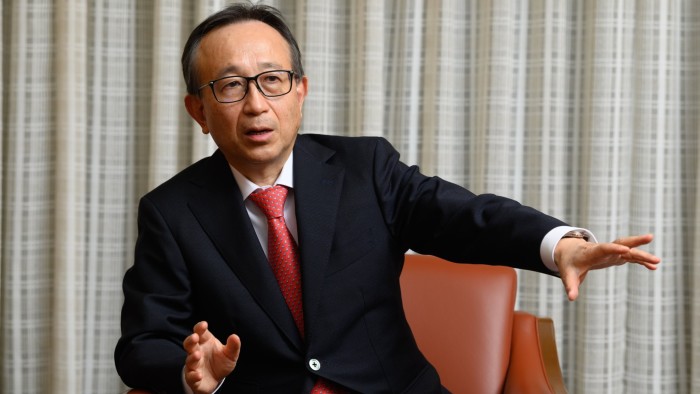Unlock the Editor’s Digest for free
Roula Khalaf, Editor of the FT, selects her favourite stories in this weekly newsletter.
The head of Mitsubishi UFJ Financial Group has said the Japanese lender could return to the ranks of the global top 10 banks by market value as it benefits from tightening monetary policy after two decades of ultra-low interest rates.
At the height of Japan’s asset bubble in 1989, the world’s four biggest companies were Japanese banks. But their relative size and global competitiveness have declined in line with Japan’s decades of economic stagnation.
“We . . . have a top 10 position within our sights,” said MUFG chief Hironori Kamezawa in an interview with the Financial Times in central Tokyo. MUFG’s market value is $140bn, while JPMorgan, the world’s biggest bank, is valued at $674bn.
The bank’s net operating profits for fiscal year 2023 have already returned to ¥1.8tn ($11.5bn), the levels hit before the Bank of Japan began its years-long experiment with negative interest rates in 2016. The bank’s share price has risen 47 per cent this year as Japan’s stock markets enjoyed a revival in response to economic reform and geopolitical tailwinds.
For years, Japan’s bank profits were hit by low interest rates, with lenders getting lower yields for their deposits. But as interest rates increase, profits are expected to rise along with net interest income, the difference between what is paid on deposits and earned from loans.
“The yield curve was flat under negative interest rates . . . but now with normalisation, money will start to circulate,” said the MUFG chief. “There will be a risk appropriate to the return.”
Inflation-conscious customers will also be incentivised to take on more risky investments order to generate higher returns, said Kamezawa. He added that due to the hunt for yield, MUFG’s deposits might decline after they increased by approximately ¥30tn over the five-year period from the end of March 2019 to the end of March 2024.
However, Kamezawa said revenues from the group’s asset management, wealth management and investment banking business should cushion the blow.
The bank makes more than half of its revenues from its international business, helped by two joint ventures with Morgan Stanley and an international push to grow beyond its ageing domestic market.
“MUFG has built a diverse business and managed to expand interest income and fee income over the last 10 years,” said Makoto Kuroda, an analyst at Goldman Sachs in Tokyo.
On Thursday, as it reported strong second quarter earnings, the bank raised its full year profit forecast 17 per cent to ¥1.75tn and increased its buyback target by ¥300bn.
MUFG has also benefited from a weak yen. According to Goldman Sachs, for every ¥1 rise in the exchange rate against the dollar, MUFG gains ¥7bn in net income. The bank currently assumes a rate of ¥140 a dollar for this fiscal year ending in March.
There are some risks to Japanese lenders posed by policy normalisation, including the impact of higher rates on smaller companies and households paying mortgages. However, Kamezawa believes that regional lenders are more exposed to those risks.
Kamezawa said he was wary of growing political instability both abroad, where a Trump presidency threatens to inflame trade tensions, and at home, after Japan’s ruling Liberal Democratic party was stripped of its coalition majority last month.
The domestic turmoil could jeopardise energy initiatives in the import-dependent country, warned Kamezawa.
“I hope that the current administration will set forth the grand design for energy policy,” he said. “Otherwise, there is a lack of visibility and predictability when it comes to the investment by our corporate customers, which would hinder our investment and lending.”
https://www.ft.com/content/cfc2fd75-bddd-40df-8b49-5efed223a0e0


